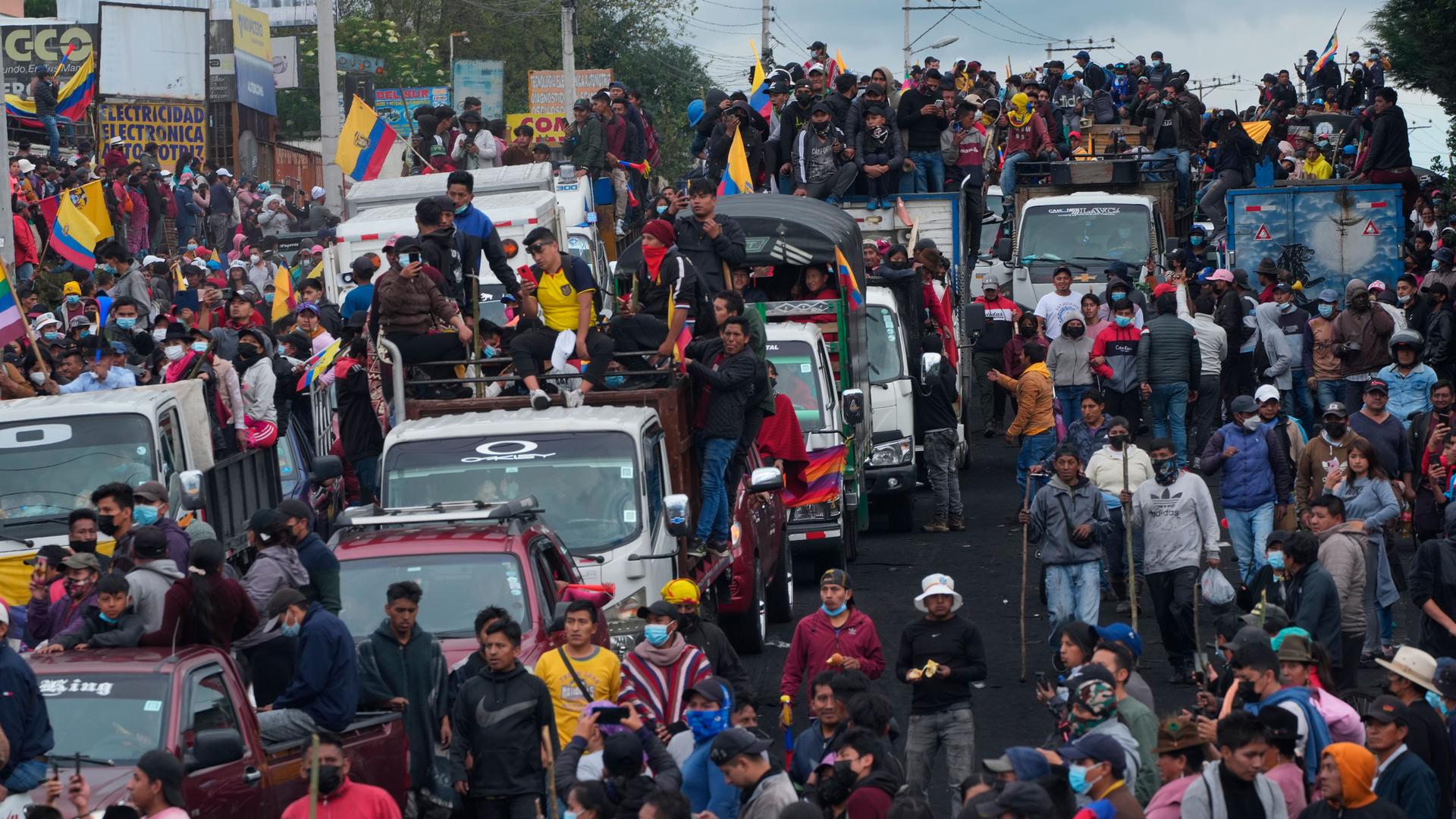On Monday, thousands of Indigenous people from tribes across Ecuador marched to the capital Quito, marking the eighth consecutive day of protest.
“The people united will never be defeated,” chanted a group of people as they crossed a bridge in the direction of the capital, livestreamed over Facebook by one local news channel.
“We are here with one idea, one heart. … We will continue to fight until they respect our rights.”
“We are here with one idea, one heart,” said one leader from the edge of the march alongside a row of burning tires. “We will continue to fight until they respect our rights.”
Indigenous groups are rallying for a range of rights that have been long-neglected in Ecuador; it’s turning out to be one of the largest protest movements the country has seen in recent years.
They say many live in chronic poverty and lack basic access to education. Those who live in the Amazon have also been devastated by foreign oil operations, and newer mining projects are also threatening their land.
Indigenous people make up roughly 6% of Ecuador’s population, according to government figures. And 70% of Ecuadorians are mestizo, with mixed Indigenous and European ancestry.
Conservative banker Guillermo Lasso was elected last year on a campaign promise to revive the economy, erase the deficit and jumpstart oil deals. But this didn’t sit well with most Indigenous groups.
Indigenous leaders tried to negotiate with the Lasso administration, but after getting nowhere, they started protesting last week.
They have 10 demands including: reducing the price of gas, halting new mining and gas projects, providing funds for health care and education, and economic relief for millions of families in debt.
“Down with Lasso. Down with Lasso,” cried supporters lining the side of the road as Indigenous people from the Amazon made their way through a town south of Quito.
“For the last year, we have democratically requested that they listen to these 10 demands,” said Leonidas Iza Salazar, the president of CONAIE, the country’s largest Indigenous confederation, which is leading the protests. “The president of the republic should respond to these substantial issues to support the Ecuadorian people,” he said.
State security forces have been cracking down on the protesters.
Videos posted over social media show people running and state forces firing rubber bullets and tear gas canisters into crowds at close range.
In another, a man’s face is covered in blood. He takes a sip of water while someone yells, “Get him to the hospital.”
President Lasso has decreed a state of exception in six provinces, giving security forces increased power and limiting some civil liberties, such as prohibiting large gatherings.
An overnight curfew is in effect in the capital of Quito.
“Even in a state of exception, state forces should not unnecessarily harm demonstrators,” said Maria Espinosa, a lawyer with Amazon Frontlines, a group that supports Indigenous organizing in Ecuador.
“But they are attacking people disproportionately. They are using weapons, not just with the goal of dispersing the crowds, but with the goal of attacking.”
Dozens have been injured and detained. One person has been killed.
As of Monday, roadblocks made of burning tires, trees, and debris stretched north and south across the country.
“Here we are!” yells someone off camera in this video shared over Twitter, as members of an Amazonian Shuar community stand around several huge trees blocking the highway.
In a message over social media on Monday, President Lasso attacked the Indigenous movements for violence and vandalism.
“We cannot allow a few violent people from stopping millions of Ecuadorians from working,” he said. “I am here to defend Quito, each family and the country.”
But Lasso’s words may not sway public opinion.
During the pandemic, Ecuador’s health care system and economy took a beating, and they still haven’t rebounded. Now, more sectors of the middle class are backing the Indigenous protests.
Quito-based political analyst Decio Machado said Lasso’s popularity has slumped below 20%.
“The country right now is in a situation of absolute tension, because there is brutal polarization between the protesters and the few people who support the government, plus the state security forces, which are mobilized across the country and which are repressing the people.”
“The country right now is in a situation of absolute tension because there is brutal polarization between the protesters and the few people who support the government, plus the state security forces, which are mobilized across the country and which are repressing the people,” Machado said.
Last week, Lasso responded to the Indigenous protests by promising to fix the health system, double the budget for education in Indigenous languages and increase credit and subsidies for farm workers.
Indigenous leaders said these are positive steps, but don’t address the overarching issues.
Protest leaders say they will not back down.
And if past national actions in Ecuador are any sign of what is to come, tension on the streets in the coming days will continue.
“Lasso’s government has its back against the wall,” Machado said.
“The fear that it may fall is creating violent tension in the streets. And the situation of tension could result in many deaths. That’s our biggest concern.”
